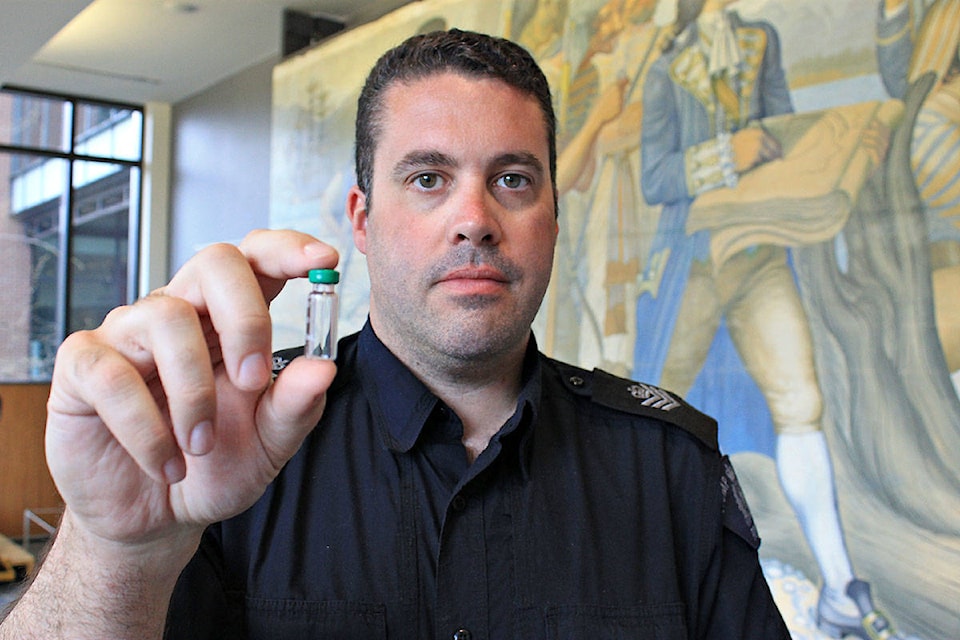RCMP Sgt. Eric Boechler, with the federal serious organized crime section, holds out a small glass jar sprinkled with so little sugar, it looks like dust.
If it was fentanyl, the two milligrams in the jar would be enough to kill.
Last Thursday first responders from across Vancouver Island converged in Nanaimo for a workshop to help them safeguard against exposure to fentanyl – an opioid requiring safety precautions that aren’t needed for any other drug.
More than 100 people learned about the dangers of fentanyl, how to identify it and handle it safely, while law enforcement members and investigators also heard about trends in fentanyl trafficking, investigations and prosecution strategies, according to a press release from the Justice Institute of B.C., a partner in the two-day workshop that will also happen in Prince George and �������� this month.
Drug overdoses have created a public health emergency. Across the province, 374 people have died as of the end of March and preliminary data suggests the proportion of deaths in the first two months of this year where fentanyl was detected was 61.2, a report from the B.C. Coroners Service shows.
Staff Sgt. Conor King, with the Victoria City Police Department and co-producer of the workshop, said fentanyl is highly dangerous and lethal in small quantities.
Fentanyl is considered 100 times more potent than morphine, while carfentanil is 100 times more potent than fentanyl, according to the federal government. Not only are users at risk, but also the first responders who come in contact with the drug during investigations or treatment of overdose patients.
The exposure risk is great, said King, adding fentanyl can be absorbed through the skin, breathed in or enter the body through membranes like the eyes.
“Part of the instructions that we’re providing is the proper use of personal protective equipment to safeguard first responders from a fentanyl overdose or fentanyl exposure and that can happen when say, police officers enter a drug dealers’ house where they are either selling fentanyl or they are converting fentanyl into counterfeit pills,” he said.
First responders do have resources. Police now carry naloxone for their own safety as well as for civilians, and King said some organizations have created their own fentanyl safety regulations, in-house training and issued personal protective equipment. The RCMP also has a clandestine laboratory enforcement and response team of specialized officers who can respond to a situation where there’s potential for fentanyl exposure, but King said the resource is time consuming and finite and there’s worry about paramedics, firefighters and police officers dealing with overdose patients day in and day out who need a basic level of training.
Front-line officers “don’t necessarily have the information we’d like them to have,” he said.
A few months ago, www. was developed for first responders by the Justice Institute of B.C.
“I wish we would have started a couple of years before now. We didn’t really anticipate that it’d become the problem it has become and now we’re working feverishly to try to catch up to keep people safe,” King said.
The workshops, first launched last year in Victoria and Vancouver, are considered unprecedented. The issue is so big from a global perspective, officers from across the country attended in 2016 as well as DEA agents from the U.S., according to Boechler, who said this year Bermuda is sending two officers because it’s starting to see fentanyl.
“We were the first ones to have these dedicated workshops, setting up pill press operations so that candidates can actually see this stuff that, again, might save their life,” said Boechler, adding that given the epidemic started in B.C., and Vancouver area, they have been forced to learn on the fly.
Boechler said there have been responders exposed to fentanyl, but none have died.
“This is a very, very dangerous situation not only to the people who use drugs on the street but also to the first responder community who are trying to go out there and help people — but we also need to go home to our families.”
Kim Irwin, exhibit custodian for southern Vancouver Island traffic services, said she was at the workshop because the “more educated we can become, the better.”
She works in a small office and already takes precautions, such as having naloxone, the antidote to opioid overdoses, on hand. She said there’s heightened awareness of what the drug can do even in the smallest dosage and it’s changing the way offices are structured, ventilation and the inability to move exhibits anywhere out of the exhibit area. If someone thinks there’s fentanyl, it’s triple bagged, she’s gloved up and masked.
Jason de Jong, fire rescue services coordinator at Cowichan Valley Regional District, said firefighters are driven to help, “but we’ve got to take that extra half-step back, take a couple breaths and have a look at the scene that you have so you’re not walking in to hurt yourself.”
He hopes to take away strategies from the workshop and solutions for first-responder protection, a knowledge base and capacity for fire departments so they can protect themselves.
news@nanaimobulletin.com



